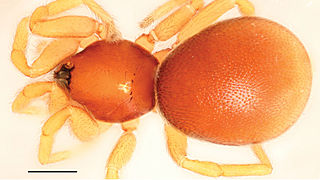
Wolf spiders are members of the family Lycosidae, from the Ancient Greek word "λύκος" meaning "wolf". They are robust and agile hunters with excellent eyesight. They live mostly in solitude and hunt alone, and do not spin webs. Some are opportunistic hunters pouncing upon prey as they find it or even chasing it over short distances. Some wait for passing prey in or near the mouth of a burrow.

Jumping spiders or the Salticidae are a family of spiders. As of 2019, it contained over 600 described genera and over 6000 described species, making it the largest family of spiders at 13% of all species. Jumping spiders have some of the best vision among arthropods and use it in courtship, hunting, and navigation. Although they normally move unobtrusively and fairly slowly, most species are capable of very agile jumps, notably when hunting, but sometimes in response to sudden threats or crossing long gaps. Both their book lungs and tracheal system are well-developed, and they use both systems. Jumping spiders are generally recognized by their eye pattern. All jumping spiders have four pairs of eyes, with the anterior median pair being particularly large.

Huntsman spiders, members of the family Sparassidae, are known by this name because of their speed and mode of hunting. They are also called giant crab spiders because of their size and appearance. Larger species sometimes are referred to as wood spiders, because of their preference for woody places. In southern Africa the genus Palystes are known as rain spiders or lizard-eating spiders. Commonly they are confused with baboon spiders from the Mygalomorphae infraorder, which are not closely related.

Kandy is a major city in Sri Lanka located in the Central Province. It was the last capital of the ancient kings' era of Sri Lanka. The city lies in the midst of hills in the Kandy plateau, which crosses an area of tropical plantations, mainly tea. Kandy is both an administrative and religious city and is also the capital of the Central Province. Kandy is the home of the Temple of the Tooth Relic, one of the most sacred places of worship in the Buddhist world. It was declared a world heritage site by UNESCO in 1988. Historically the local Buddhist rulers resisted Portuguese, Dutch, and British colonial expansion and occupation.

Oonopidae, also known as goblin spiders, is a family of spiders consisting of over 1,600 described species in about 113 genera worldwide, with total species diversity estimated at 2000 to 2500 species. The type genus of the family is OonopsKeyserling, 1835.

Meatless Flyday is a 1944 Warner Bros. Merrie Melodies directed by Friz Freleng. The short was released on January 29, 1944.

Udawattakele Forest Reserve often spelled as Udawatta Kele, is a historic forest reserve on a hill-ridge in the city of Kandy. It is 104 hectares large. During the days of the Kandyan kingdom, Udawattakele was known as "Uda Wasala Watta" in Sinhalese meaning "the garden above the royal palace". The sanctuary is famous for its extensive avifauna. The reserve also contains a great variety of plant species, especially lianas, shrubs and small trees. There are several giant lianas. Many of small and medium size mammals that inhabit Sri Lanka can be seen here. Several kinds of snakes and other reptiles might be seen. Udawattakele was designated as a forest reserve in 1856, and it became a sanctuary in 1938.

Kandy Lake, also known as Kiri Muhuda or the Sea of Milk, is an artificial lake in the heart of the hill city of Kandy, Sri Lanka, built in 1807 by King Sri Wickrama Rajasinghe next to the Temple of the Tooth. Over the years, it was reduced in size. It is a protected lake, with fishing banned.

Spiders are air-breathing arthropods that have eight legs, chelicerae with fangs generally able to inject venom, and spinnerets that extrude silk. They are the largest order of arachnids and rank seventh in total species diversity among all orders of organisms. Spiders are found worldwide on every continent except for Antarctica, and have become established in nearly every habitat with the exceptions of air and sea colonization. As of July 2019, at least 48,200 spider species, and 120 families have been recorded by taxonomists. However, there has been dissension within the scientific community as to how all these families should be classified, as evidenced by the over 20 different classifications that have been proposed since 1900.
George Henry Kendrick Thwaites was an English botanist and entomologist.

Poecilotheria smithi, or the yellow-backed ornamental, is a species of large arboreal tarantulas. It is endemic to Sri Lanka and considered to be critically endangered.
Plagiobothrus is a monotypic genus of Asian brushed trapdoor spiders containing the single species, Plagiobothrus semilunaris. It was first described by Ferdinand Karsch in 1892, and has only been found in Sri Lanka, documented from the regions of Peradeniya and Kandy. It is about 24 millimetres (0.94 in) long and has a deep brown carapace and limbs. Its abdomen is black above and brown beneath.
Murricia crinifera, is a species of spider of the genus Murricia. It is endemic to Sri Lanka. The species was described with a female specimen collected from Kandy, Galle and Colombo.
Merizocera is a genus of six eyed spiders in the family Ochyroceratidae, first described by Jean-Louis Fage in 1912.
Wanniyala hakgala is a species of spider of the genus Wanniyala. It is endemic to Sri Lanka. The species was described with a male found from Hakgala area, hence the specific name.
Xestaspis sublaevis, is a species of spider of the genus Xestaspis. It is endemic to Sri Lanka.

Xestaspis is a genus of goblin spiders that was first described by Eugène Louis Simon in 1884.
Xestaspis paulina is a species of spider of the genus Xestaspis. It is endemic to Sri Lanka.

Leptopholcus is a genus of cellar spiders that was first described by Eugène Louis Simon in 1893.











